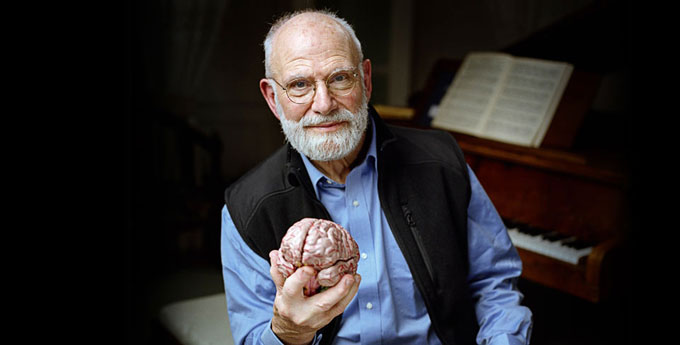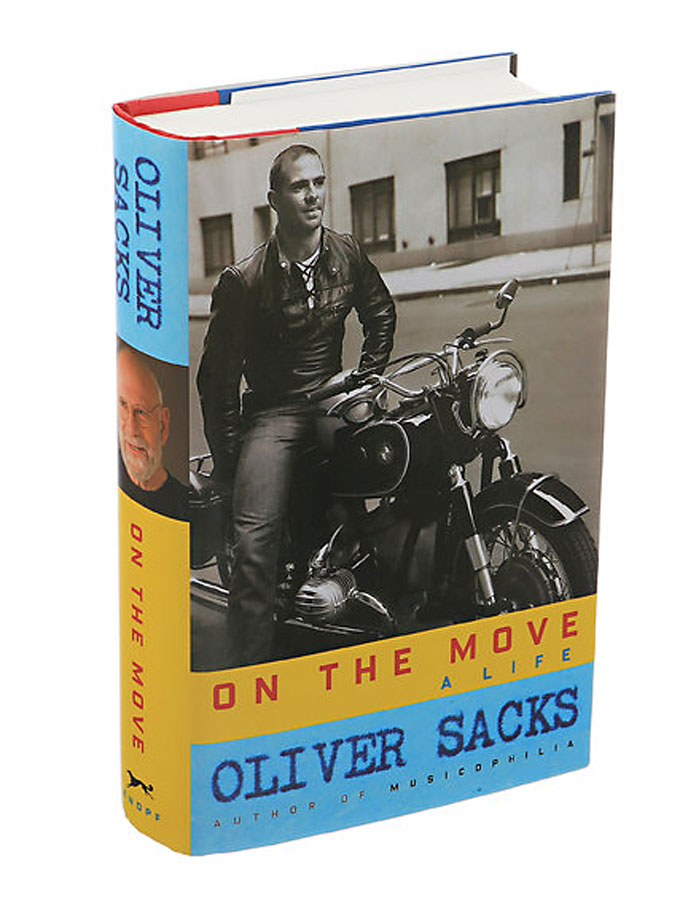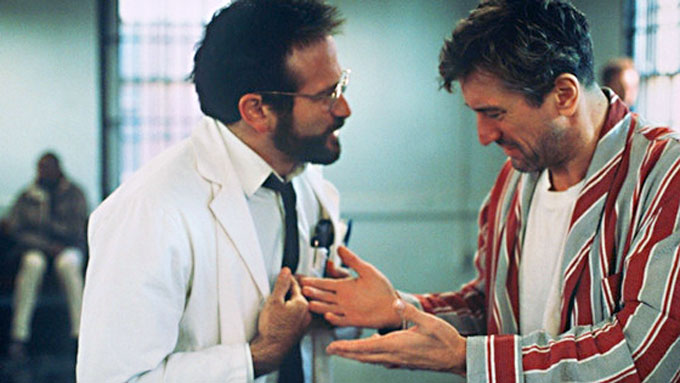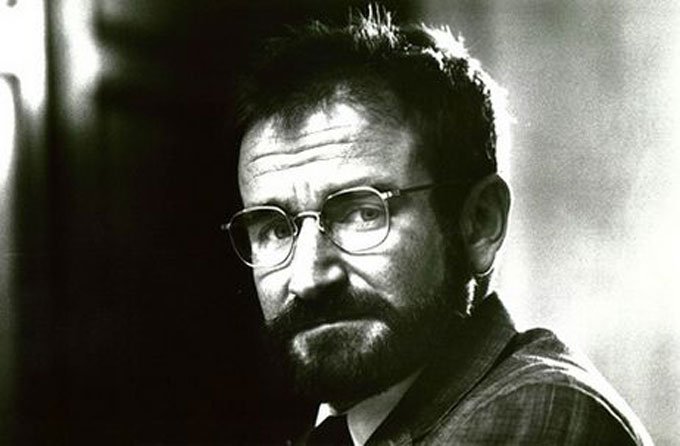The literary neuroscientist Oliver Sacks will be 82 next month. Robin Williams, who portrayed Sacks in the 1990 film Awakenings, would be 64 in July if he were still alive. Like John Steinbeck, both men broke boundaries in inspired work that defied convention, created controversy, and kept wowing the public year after year. Luckily, Sacks has written a memoir—On the Move: A Life—that will please fans of Sacks, Robin Williams, and John Steinbeck, whose novel Cannery Row moved Sacks to consider becoming a marine biologist as a boy in post-World War II England.
Sacks became a doctor instead, but he emulated Steinbeck by also becoming a bestselling writer—so brilliantly that he’s been described as the poet laureate of medicine. Migraine, his first book, was published in 1970. The next, Awakenings, appeared in 1973. It was adapted as an Oscar-nominated movie starring Robin Williams and Robert De Niro in 1989 and helped make Oliver Sacks a synonym for science you can understand.
Oliver Sacks became a doctor, but he emulated John Steinbeck by also becoming a bestselling writer—so brilliantly that he’s been described as the poet laureate of medicine.
Since Awakenings, Sacks has written more books and hundreds of articles about the miracles, mysteries, and malfunctions of the human brain, his specialty. Like Steinbeck, he records real life in his writing, narrating clinical case histories with the compelling power of the best fiction. Also like Steinbeck, he’s autobiographical by nature, and his case histories frequently include himself. Migraine grew out of his personal experience with the debilitating condition, which I learned from my former boss Dr. William Langston—author of The Case of the Frozen Addicts (1995)—is common among neurologists.
Like Steinbeck, he records real life in his writing, narrating clinical case histories with the compelling power of the best fiction.
An avid motorcyclist addicted to speed, Oliver Sacks wrote A Leg to Stand On (1984) after losing the awareness of one of his legs following an accident. A music lover who plays the piano, he wrote Musicophilia (2007) about patients with unusual musical obsessions. When cancer cost him sight in one eye he wrote The Mind’s Eye (2010), an amazing account of the ways in which visually impaired people perceive and communicate. Six months ago he learned that the cancer has spread to his liver. On the Move may be his last book.
In the first chapter Sacks recalls reading John Steinbeck’s Cannery Row as a teenager attending school outside London, where his parents and uncles practiced medicine. (Two of his brothers became doctors; a third, also brilliant, is bipolar.) After graduating from Oxford and finishing his medical training, he left England for America, where he has treated patients, taught, and written since 1960. He interned in San Francisco and completed his residency at UCLA during the period when John Steinbeck was writing The Winter of Our Discontent, Travels With Charley, and America and Americans. Though On the Move doesn’t mention meeting Steinbeck, it details Sacks’s friendship with other writers, including the poets W.H. Auden and Thom Gunn— gay men who, like Sacks, left England for the sexual freedom of San Francisco and New York.
In the first chapter Sacks recalls reading John Steinbeck’s Cannery Row as a teenager attending school outside London.
Like John Steinbeck, Oliver Sacks bloomed in California, falling in love with San Francisco, living in Los Angeles, and exploring Baja California in his travels and writing. Like Steinbeck, Sacks was influenced by the California writer Jack London, whose People of the Abyss provided a working title for the book that became Awakenings. Like Steinbeck and London, he was attracted to drugs and alcohol, suffered from depression, and found healing in the act of writing. In 1968, the year Steinbeck died, Sacks encountered the book that inspired Awakenings—A.R. Luria’s Mind of a Mnemonist: “I read the first thirty pages thinking it was a novel. But then I realized that it was in fact a case history—the deepest and most detailed case history I had ever read, a case history with the dramatic power, the feeling, and the structure of a novel.”
Like Steinbeck and Jack London, Sacks was attracted to drugs and alcohol, suffered from depression, and found healing in the act of writing.
Like Steinbeck, Sacks eventually left California for New York, where he saw patients at Beth Abraham Hospital, began writing for the New Yorker, and ended up teaching at a succession of star schools, including Columbia, New York University, and Albert Einstein College of Medicine. The true story told by Sacks in Awakenings unfolded at Beth Abraham, where comatose patients suffering from an extreme form of parkinsonianism caused by encephalitis lethargicus responded dramatically when treated with the drug L-dopa. Among them was “Lenny L,” the patient played by Robert De Niro in the movie adaptation of Awakenings. Robin Williams played Oliver Sacks, the story’s empathetic neurologist-narrator—what John Steinbeck called the authorial character found in any good novel.
The movie brought the author and the actor together in much the way John Steinbeck met Burgess Meredith and Henry Fonda 50 years earlier. Sacks reacted to Williams as Steinbeck did to Fonda—with awe. Before the filming of Awakenings began, Williams and Sacks visited a geriatric ward “where half a dozen patients were shouting and talking bizarrely all at once. Later, as we drove away, Robin suddenly exploded with an incredible playback of the ward, imitating everyone’s voice and style to perfection. He had absorbed all the different voices and conversations and held them in his mind with total recall, and now he was reproducing them, or, almost, being possessed by them.”
Then Williams began imitating Sacks, too—“my mannerisms, my postures, my gait, my speech—all sorts of things of which I had been hitherto unconscious.” The experience, says Sacks, was uncanny and a bit uncomfortable, “like suddenly acquiring a younger twin.” As On the Move reveals, however, the real Ed Ricketts figure in Sacks’s life wasn’t Robin Williams but Stephen Jay Gould, the evolutionary biologist and science popularizer who died from cancer, age 60, in 2002. Gould’s version of non-teleology, the idea dramatized by Steinbeck in Cannery Row, is called contingency, a concept drawn from modern sociobiology that would have appealed to Ed Ricketts and John Steinbeck.
The real Ed Ricketts figure in Sacks’s life wasn’t Robin Williams but Stephen Jay Gould, the evolutionary biologist and science popularizer who died from cancer, age 60, in 2002.
Like Steinbeck, Oliver Sacks as a writer engages me for personal reasons. I read Awakenings when my mother was diagnosed with Parkinson’s disease in her 70s. I read Musicophilia with the curiosity of an amateur pianist, a trait I share with Steinbeck and Sacks. I read Sacks’s earlier memoir, Uncle Tungsten: Memories of a Chemical Boyhood (2001), while working for The Scripps Research Institute. There I met another hero of On the Move, the neuroscientist Gerald Edelman, who graciously autographed my copy of his wonderful book Wider Than the Sky: The Phenomenal Gift of Consciousness (2004). Edelman, a violinist and Nobel Laureate, was suffering from Parkinson’s, another link. The final pages of On the Move are devoted to Edelman’s elegant insights (“Every perception is an act of creation”), dissecting Edelman’s metaphor of a musical ensemble to explain how our minds work through reentrant signaling, the complex process that “allows the brain to categorize its own categorizations.”
The final pages of On the Move are devoted to Gerald Edelman’s elegant insights, dissecting Edelman’s metaphor of a musical ensemble to explain how our minds work.
Like Robin Williams, Gerald Edelman died in 2014, while Oliver Sacks was writing On the Move, and Edelman’s string quartet metaphor seems a good way to end this review. As an artist Sacks, like Williams, is more virtuoso than ensemble member. As a writer, like Steinbeck he’s a restless experimenter, constantly on the move between the worlds of art and science. Williams’s genius was visual mimicry, verbal speed, and comic improvisation. Oliver Sacks’s great gift—like John Steinbeck’s—is telling stories that explore the depths of suffering and the heights of hope in words anyone can understand. It’s sad that On the Move may be his last book, but a joy to celebrate his birthday. Five stars for On the Move and a toast to Oliver Sacks!
Oliver Sacks died at his home in Manhattan on August 30, 2015. On the Move topped the list of the year’s best books compiled by Brain Pickings.—Ed.







This is a wonderful essay. Intelligent and deeply felt. Sacks and Steinbeck shared an all-seeing eye, creativity and deep humanity. I had never heard but totally agree with the Edelman observation that “Every perception is an act of creation.” It is, but it took Edelman to point it out. I observe people in a “home”; it is enlightening, but at the same time it can be heartbreaking.
Steve Hauk is an art expert and writer, the author of plays and of stories based on events from the life of John Steinbeck, and a creative contributor to SteinbeckNow.com with a wide and appreciative audience.
Mr. Ray’s essay is wonderfully written and I thank him for moving me through Dr. Sack’s life so informatively and poignantly. I found the story moving and inspiring but also bittersweet with the knowledge that the world, especially at this time, cannot afford to lose such brilliant and humane people like Dr. Sacks.
I very much appreciate Mr. Ray’s efforts.
Michael Katakis
Michael Katakis is a travel writer, essayist, and photographer and the manager of Ernest Hemingway’s literary estate. Along with that of his late wife, Dr. Kris Hardin, his work is held by the British Library. His well-known portrait of the American artist Maya Lin is held by the National Portrait Gallery.
William Ray has written passionately about Steinbeck and Sacks’ similarities. His treatise can only touch all of us and compels us to re examine both author’s books and lives.
Steinbeck wrote passionately to transition caring for mankind, as a mental, spiritual, and moral prerogative. The environment is sacred. All of mankind is inclusive. Sacks takes this a step further to include those portions of society that are often locked up by society and their own handicaps and demonstrates that with music, light, and color individuals who are prisoners of their minds can be free.
Schopenhauer once said that “Reading is thinking with other people’s minds.”
James Joyce commented. “I like the notion of the Holy Ghost being in the ink bottle.”
Oliver Sacks demonstrates the truth of both observations.
One can easily contend that the ink of Steinbeck and Sacks touch mankind and elevates us to a higher state.
Sacks writes:
“To live on a day-to-day basis is insufficient for human beings; we need to transcend, transport, escape; we need meaning, understanding, and explanation; we need to see over-all patterns in our lives. We need hope, the sense of a future. And we need freedom (or, at least, the illusion of freedom) to get beyond ourselves, whether with telescopes and microscopes and our ever-burgeoning technology, or in states of mind that allows us to travel to other worlds, to rise above our immediate surroundings.
We may seek, too, a relaxing of inhibitions that makes it easier to bond with each other, or transports that make our consciousness of time and mortality easier to bear. We seek a holiday from our inner and outer restrictions, a more intense sense of the here and now, the beauty and value of the world we live in.”
― Oliver Sacks
Laurence Smith is an artist and Oliver Sacks fan born and reared in Washington, D.C.
Thank you for this very interesting and thoughtful essay. I met Oliver Sacks many years ago when he spoke at Rush University, during my Neurology Fellowship in Movement Disorders. As a neurologist, I have followed his career with interest, through his books, articles and interviews. It is fortunate that the authors we love leave such a rich legacy of written words for us to treasure after they depart this plane.
Dr. Melanie Brandabur is a Bay Area neurologist with leadership experience in Parkinson’s disease research and treatment.
Your excellent and compelling essay prompted me to read “On the Move” and to view the DVD, “Awakenings.” Oliver Sacks’s total immersion in the healing art reminds me that Dr. Sacks, like his parents, represents a dying breed in the medical profession. He knows his patients intimately and can minister to their needs on many levels beyond diagnosis and pharmacology. His connection to music is of particular interest to me. Why is there an apparent affinity between physicians and creating/ listening to music? I have known a few colleagues in the medical profession who were also performing musicians. In each case the doctor was an accomplished musician long before he went to college or medical school. In each case he opted for a medical career as an extension of a desire to help and heal people. From my observation, the idealism to create music as a balm to the spirit and a source of solace is all part of the healer’s art, whether the practitioner is a violinist or a pediatrician. An inveterate concert goer, Dr. Sacks drew spiritual renewal from listening to classical music, and he was never far from his cherished home piano. He also identified remarkable therapeutic benefits from music, as in the case of a post encephalitic patient who had a kind of “quickening” that was separate and independent from the effects of L dopa. Like all great physicians, Dr. Sacks is a master in the art of communication—verbal, non-verbal, written, intuitive, and emotional, and part of his great legacy is the ability to harness the communicative elements for the benefit patients and readers the world over.
Frank Ashdown
Dr. Franklin D. Ashdown is a physician, recently retired, in New Mexico, and a prolific organist and composer of organ and choral music that is performed by artists and ensembles worldwide. His “Steinbeck Suite for Organ” can be heard in its premiere performance by the California organist James Welch at https://www.steinbecknow.com/2014/04/25/steinbeck-suite-pipe-organ/